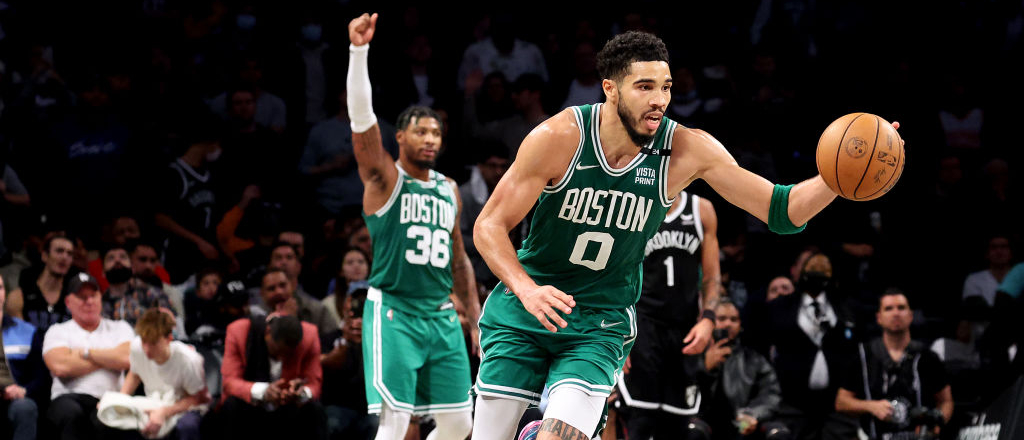
On January 26, the Boston Celtics stood at 22-22 in 11th place in the Eastern Conference without a clear road map to title contention. First year head Ime Udoka struggled to implement a new switch heavy defensive system that required a high level of communication and trust to execute. A Celtic roster anchored by players mostly under 26 felt stale and the burden of early success hovered of the team like San Francisco fog. Boston had advanced to the conference finals in three of the previous five seasons, but their season and roster construction stood at a major crossroads.
Instead of making a ground-shaking trade, Ime Udoka delivered a strong but simple message to his team: play better. And that they did. Boston went 29-9 down the stretch finishing second in the Eastern Conference with the league’s best defense. They finally broke through the conference finals ceiling in their fourth trip, but after losing in six games to the Warriors, they new enter the offseason facing one of the most difficult questions in sports: How do they improve their roster to take another step forward next season without sacrificing what made them a Finals team this year?
Jaylen Brown and Jayson Tatum proved their partnership worthy this season with their stellar 2-way play down the stretch of the regular season and throughout the postseason. Their offensive fit has always attracted doubt because their skill sets do not amplify one another, but that analysis shifts the blame in the wrong direction. Jaylen and Jayson have yet to play with a point guard that generates easy looks for the tandem without causing a constant fire drill on defense. While Jaylen and Jayson may not amplify each other on offense, they certainly do that on the defensive end. Life is very difficult when you constantly have to generate perimeter offense against two rangy athletic wings who have premiere rim protection lurking on the backline. The duo is a clear answer to Boston’s championship’s aspirations.
Tatum’s production throughout the Eastern Conference playoffs solidified his position as a top 10 player in this league. He out dueled Kevin Durant, Giannis Antentokoumpno, and Jimmy Butler in consecutive series while playing world class defense for 41 minutes a game; it was true superstar play. Game 6 in Milwaukee will go down as the defining game in Tatum’s young career where he scored 46 points while facing elimination and stuck dagger after dagger in the defending champs with his fourth quarter shot making.
However, in the Finals, Golden State put a black light on Tatum’s flaws showing the steps he still needs to take to reach the highest echelon of player in the NBA. Tatum struggled to generate clean looks within arc and completely lost the ability to finish at the rim. He shot 36 percent from the field, which is the second lowest mark in a series in his career. Golden State completely flustered Tatum on drives with their ability to shade towards the paint mostly behind Draymond Green’s defensive direction and execution. Tatum’s struggles in the paint were compounded by the his constant turnovers that seemed to infect the entire team. After an absolutely stellar season, Tatum failed to rise to the challenge in the Finals. To reach the promised land, Tatum will need to improve his playmaking and ability to dictate the pace of the game even when his jumper isn’t falling.
While Tatum struggled to control the game and limit turnovers, he did not receive much help from his starting point guard. Marcus Smart the true alpha and omega of the Celtics, for better or worse, also struggled to win the possession game for Boston. The Defensive Player of the Year is the emotional core of the Celtics, but Boston needed a steady hand to calm the waters against the Warrior runs he could not provide that during the Finals. Smart has always been the lightning rod of this Celtics core and instead of moving him at the trade deadline, Ime Udoka made Smart the full-time starting point guard. That unleashed the hellacious Celtic defense that spurred their run to the Finals, but Smart still leaves some meat on the bone as a playmaker at the highest levels of basketball.
The decision to ride with Smart will be a pivot point for the Celtics moving forward. Could they have won this series with a steadier point guard? Or would the defensive drop off put Boston too far behind the 8-ball on defense? That’s the line Brad Stevens and Ime Udoka will have to straddle moving forward in an Eastern Conference that will only grow more competitive.
They don’t have to look far to see the perils of running it back after a surprising playoff run. After falling just shy in 2020, the Heat got bounced in the first round a year ago with mostly the same roster before making some big additions last summer to vault back to the top of the East. The Hawks faced a similar fate after running it back coming off of a stunning Conference Finals run a year ago, and now are expected to make major moves this offseason got find their way back.
Boston should absolutely believe in its star duo and feel good about plenty of other areas on the roster — even hobbled, Robert Williams was nothing short of terrific in the Finals — but there are areas in need of improvement and not addressing those is a trap they can’t fall into. Success in the NBA only begets more pressure to back that up, and being able to be proactive in roster building is the greatest attribute an organization can have.
This Celtics team got a taste of the NBA Finals, but the resulting appetite will make every decision moving forward that much harder.
